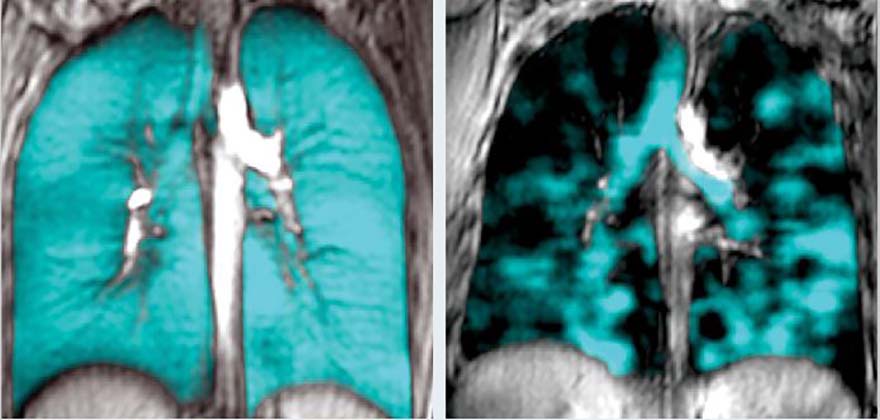Vaping Contrast
Imaging technology is showing the dire consequences of vaping on lungs
By Crystal Mackay, MA’05
The images side-by-side are strikingly different. The one on the left, a healthy pair of lungs showing blue inhaled gas that fills the lungs completely. The one on the right, the lungs of a young person who vaped for a few months and became severely ill. The numerous dark regions show areas in the lungs that are blocked from inhaled air.
“Our early results in vapers are driving our research in a new direction because we really want to understand what this means for children and teenagers over the long term. Because our techniques are so sensitive, we are revealing abnormalities that can’t be detected using CT or pulmonary function tests.” — Grace Parraga, HBSc’84, MSc’86, PhD
Grace Parraga, HBSc’84, MSc’86, PhD, Canada Research Chair in Lung Imaging to Transform Outcomes and Professor in Medical Biophysics has generated and examined the images of thousands of lungs in the past decade and never before has she seen anything like this.
“We are seeing a lot of patchiness in the lungs of young vapers. We never see this in young healthy lungs,” she said. “The regions of the lung that have markedly abnormal ventilation tell us that when they breathe, air is being choked off from much of the lung, and we now think we know why.”
When reports of vaping-related lung injury were emerging across North America, and the first Canadian case was reported in London, Ontario, Parraga and her colleagues were struck by the severity of disease that was being seen in young previously healthy people.
A lung imaging scientist who focuses her research on finding a cure for asthma and COPD, she pivoted her team’s research to begin investigating exactly what was going on inside the lungs of vapers.
“From a societal point of view, vaping has been pitched to these young people as a safer alternative to cigarette smoking, but as the imaging shows, we can see that vaping is not safe,” said Parraga.
Using a specialized MRI method in her lab at Robarts Research Institute and using an inert gas that research participants inhale into their lungs, it is easy to see where the gas goes in the lungs, and more importantly, where it doesn’t go when it is blocked by destroyed airways and tissue.
The technique, also allows the team to measure the integrity of the tiny airsacs in the lungs, as well as the tissue lining the airsacs where oxygen and carbon dioxide are normally exchanged.
“Our early results in vapers are driving our research in a new direction because we really want to understand what this means for children and teenagers over the long term,” she said. “Because our techniques are so sensitive, we are revealing abnormalities that can’t be detected using CT or pulmonary function tests.”
Parraga says the lungs are overengineered for everyday life - designed for intense exercise from the prehistoric days of hunting and avoiding predators. Because of this, symptoms don’t present during day-to-day activities until the damage is quite severe.
She says because this same technology wasn’t around in the early days of smoking, they weren’t able to glean this kind of information about the damage until it
was too late.
“Research provides hope to find the truth. We have sensitive tools and young vapers who are concerned about their health, so this is an extremely hopeful story,” she said. “It is going to help us more deeply understand what’s actually going on.”
Canada’s First Published Case of Vaping Related Lung Injury
Late in 2019, a London, Ontario team published details on Canada’s first case of suspected vaping-related lung injury and described a new type of injury from vaping products similar to ‘popcorn lung’. ‘Popcorn lung,’ is a condition seen in microwave popcorn factory workers exposed to the chemical diacetyl, and causes the small airways in the lungs become inflamed and damaged. The team from Lawson Health Research Institute and University Health Network (UHN) included Schulich Medicine & Dentistry Associate Professor Dr. Karen Bosma and Medical Fellow Dr. Simon Landman. “Given the patient’s vaping activity and the absence of other causes, we suspect his lungs became damaged from vaping compounds,” said Dr. Bosma. “We want the medical community to be aware that vaping-related lung injury may present in many different ways, and to report any cases to Health Canada for further investigation,” said Dr. Landman. “We are urging patients and their families to take vapingrelated lung injury seriously, and recognize that vaping may cause both short- and long-term injury to the lungs.”









